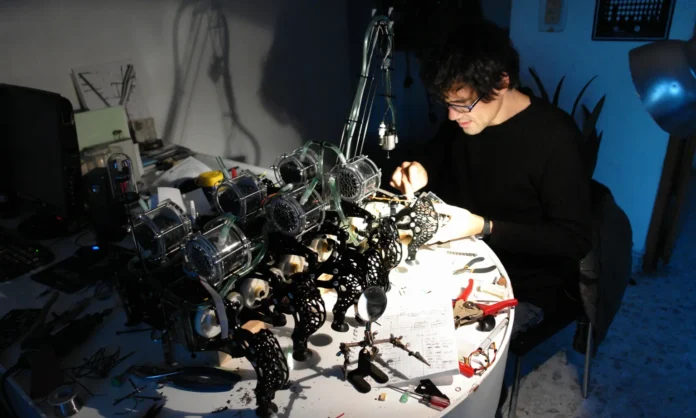Mexican visual artist Gilberto Esparza works with technology, including electronics, robotics, and biotechnology, to develop innovative solutions to the detrimental impact that humans have had on the natural world, particularly on water. His overall goal is to rethink and redo the current relationship between human society and the environment by establishing collaborations between the two.
Esparza’s work is currently part of Common Frequencies (May 1 – Oct.15, 2021), a group exhibition of four cross-disciplinary Mexican artists and one collective at BioBAT Art Space in Brooklyn, New York. Curated by Elisa Gutiérez, the exhibition explores the intersection of art and science through sound, urban ecology, language, and the construction of symbolic imageries. In addition to Esparza, it features the work of Tania Candiani, Lorena Mal, Marcela Armas and the Interspecifics Collective.
NOMADIC PLANTS
In 2008, Esparza began the process of developing Nomadic Plants (Plantas Nómadas), his first project addressing urban and industrial water pollution. A collaboration between technology (a robotic system), plants, and bacteria, it took six years of research and experimentation to create the final product. The robot extracts polluted river water, stores it in a group of microbial fuel cells (think biological batteries) where the bacteria in the water itself break down the toxic substances to create clean water that, in turn, feeds the living plants. At the same time, the bacteria generate energy to recharge the batteries. Esparza’s research indicated that the more polluted the water, the more energy it produced. Over the course of the project development, as he does with all of his projects, he worked with a team of engineers and biologists to create the robotic system.
Esparza has taken Nomadic Plants to a series of polluted rivers in Mexico and, in each locale, talked with the local residents about the critical water pollution problem that exists in 70% of Mexico’s rivers. While he was setting up the robot, he observed that it was always the children who came first to see what he was doing, then their parents, and finally the school teachers. Although he educates residents and city leaders about the need to address the fresh water crisis, Esparza admits that any small efforts that are attempted to clean up the contaminated rivers fail because of the high levels of corruption in Mexico. The irony of Nomadic Plants is that the robotic system as a distinct “species” only lives as long as there are polluted rivers. Once the rivers are cleaned, it will become extinct
In 2020, Esparza completed a 360º rendering of Nomadic Plants situated in its habitat on the banks of a polluted Mexican river, showing the robotic system as well as the local manmade and natural environments.
For the exhibition, Esparza used salt water for the first time and water from the Gowanus Canal in Brooklyn, which is regarded as one of the most polluted bodies of water in the United States. What he ultimately wants to do with BioSoNot is to create a playlist or record of the sounds he has recorded from contaminated river water and invite artists to interpret the sounds. The playlist would allow listeners to hear the different sounds made according to the level of water pollution existing in a particular river, or to give voice to the polluted waters.
The overarching message behind Esparza’s remarkable projects is the importance of leaving nature alone and “making friends with bacteria.” From his extensive research on bacteria, he is convinced that on a large scale, if we simply stop polluting, the rivers would clean themselves. To us, his work may seem quite complicated, but Esparza insists that what he does is simple; it is the biological processes of nature that are beautiful, complex, and regenerative.
Analysis:
This article focuses on the artist Gilberto Esparza and his work with technology and illustrating the effect that human have when it comes to the environments. In one of his works, he creates a device that focus on creating playlist based on the pollution in the water. This article stands out in the manner in which it combines art with technology to make unique idea that create conversation within society.




